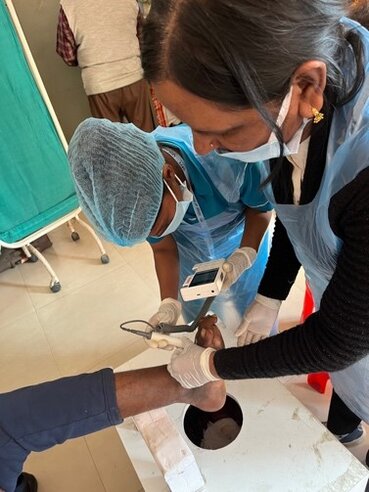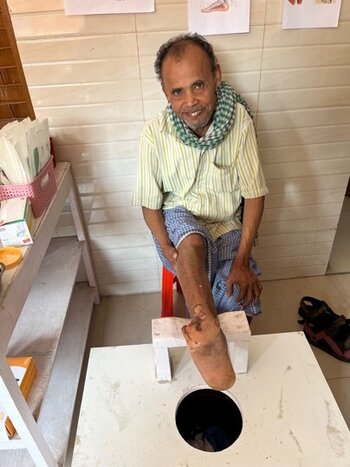Village of Hope Report 2024
Published by Ali Clark-Morris #, Podiatrist in News · Monday 25 Mar 2024
Ali has recently returned from her annual visit to Delhi and here is her update..
She thanks everyone for their continued support/interest and she would also like to thank podiatrists who have visited in previous years, without whose input, they would not have been able to achieve all that they have. 2024 was an extremely rewarding visit and Ali has come away for more plans for the future.
Team 2024 comprised of :-
Ali Clark-Morris Podiatrist, Private Practice, Feetwise Footcare, Berkshire https://feetwisefootcare.co.uk/about-us/
Eloise Clark-Morris Engineering graduate, now working for Casenove Capitol, Client Service Executive
https://www.cazenovecapital.com/en-gb/uk/wealth-management/
https://www.cazenovecapital.com/en-gb/uk/wealth-management/
Sangeeta Dhall, Podiatrist in Private Practice at Walkel clinic, Herts. https://www.walkwel.co.uk/about-us/meet-the-team, Fluent in Hindi

Our Aims and Objectives
1. To ensure that staff are trained and confident to use Doppler ultrasound to assess blood flow to patients’ feet.
During the first week we set aside time at lunch time to train Jolly (assistant bandager), Vijay (bandager) and Shekar (Cliniko administrator). It was a fun session; a couple of students joined us and afterwards we encouraged the staff to use the Doppler as much as possible. It was so heartwarming to see them, during our second week, explaining to the nursing, the reasons for its use and showing them how to use it. The patients were fascinated and I, personally, think that psychologically it had a very positive impact, helping them connect their numb feet to the rest of their body. I am confident that they will continue to use Doppler as an assessment tool for every patient and thereby, detect feet with vascular impairment earlier.


2. To train the new member of staff to use the Cliniko data management system and clarify the reasons and the importance for its use.
We had a one hour session with staff before we started our first clinic explaining how to use Cliniko. We emphasised that this is a valuable tool for data collection (e.g. number of patients seen for treatment, number of patients seen by the doctor, number of patients with diabetes etc.) Eloise then, followed up the training by overseeing and supporting Shekar in clinic until he was proficient and confident using Cliniko.


We also taught staff how to score wounds using the SINBAD scoring system, considering, size, site, depth, blood supply and presence of infection and neuropathy. By recording this information, we can ascertain if wounds are getting better or worse and gauge approximately how long they should be taking to heal and the risk of amputation as an outcome.
3. To establish a better link between the bandaging unit at The Village of Hope and the neighbouring Leprosy Mission Hospital
We had a fruitful trip to The Leprosy Mission Hospital (TLM), spending time with the Hospital’s Superintendent.
During this meeting, it was agreed that the bandaging staff will attend the dressing clinic at TLM every 3 months for training and most importantly to liaise and build a relationship between the two sites.

During this meeting, it was agreed that the bandaging staff will attend the dressing clinic at TLM every 3 months for training and most importantly to liaise and build a relationship between the two sites.

This will establish far better integrated care for the patients. We were then given a tour of the hospital.
During the tour, we met a 10-year-old girl who had come in for surgery on her hand. The leprosy had caused clawing of her fingers and that is how she first came to know she had the disease. She and her mother have not told anyone in her village about her diagnosis due to the likelihood that she will be ostracised by her village and family.
We also spent some time in the orthotic/footwear lab with the physio/orthotist or ‘jack of all trades’ as he liked to describe himself.
During the tour, we met a 10-year-old girl who had come in for surgery on her hand. The leprosy had caused clawing of her fingers and that is how she first came to know she had the disease. She and her mother have not told anyone in her village about her diagnosis due to the likelihood that she will be ostracised by her village and family.
We also spent some time in the orthotic/footwear lab with the physio/orthotist or ‘jack of all trades’ as he liked to describe himself.


4. To ascertain whether there is a need and feasibility of establishing a footwear/orthotic laboratory within The Village.
I have been approached by a lecturer in Podiatry at Cardiff Metropolitan University, who together with a wound care specialist and a lecturer in design and technology at the university, is keen to establish footwear and orthotic provision in the Village itself. On talking to staff at the hospital and the programme leader at The Village of Hope, I am excited to report that this vision is achievable. It will need thought, research, and funding but it will be so worthwhile to the patients, many of whom cannot access to the TLM for a variety of reasons. As you can see for the photos there is a definite need for this service!

5. To film and interview the staff and patients to make a promotional video for prospective podiatrists and benefactors.
Sangeeta has a daughter who works for the BBC. She has very kindly offered to edit and produce a video for us. Sangeeta managed to interview many people and film footage during our visit. Once the video is finalised, I will share it with you.
6. Review the impact that the weekly doctor’s visits are having on the clinic.
Since I was last at The Village, Hope Worldwide have started funding weekly doctor visits to the clinic. This is something that has been on my wish list since my very first visit in 2017. He is a retired doctor with experience in the field of Leprosy. He attends every Wednesday and offers advice to the patients and will prescribe medication for neuropathic pain and infection. Both Sangeeta and I were able to make use of his expertise while he was in attendance. This patient has exposed bone so very likely has bone infection. Antibiotics were prescribed, the doctor will keep a close eye on the foot and if there is any deterioration he will refer him to TLM. We might not save the foot in its entirety, but we will save the leg. He looks happy because he has had his circulation and blood sugars checked as well as receiving antibiotics. A complete service!


7. To utilise a Hindi speaker to better understand the patients and their backgrounds, and to ascertain their needs and how we can help and empower them.
Having Sangeeta as part of the team emphasised the importance and value of having an interpreter in clinic. I learned so much more about the patients and their lives and she relayed some sad stories to me. One man in particular who, on being diagnosed has been totally neglected and deserted both physically and financially by his family. Thanks to the Village of Hope he has a roof over his head and food in his belly. Since the Village of Hope was built only 5% of village residents now beg for a living. That 5% is mainly made up of users of the bandaging service and so 80% of our patient cohort beg for a living. Time at the bandaging unit is time they could be spending begging and so unfortunately their foot health is often not a priority hence wounds deteriorate, or they wait to access the service only when they have a serious problem.


Added extras
Eloise’s expertise was not just limited to Cliniko data collection, she was appointed with the task of offloading wounds by making poron insoles, at which she excelled.
We have provided the unit with a glucose monitor. Patients with diabetes can now have their blood sugars checked and the appropriate advice given to them during their visit to the clinic.

A further 12 tricycles were distributed.


Plans for the future



On that note, I will sign off. Many thanks from me and the patients for your continued interest and support.
Please feel free to message me if you would like any further information about our work at The Village of Hope.




